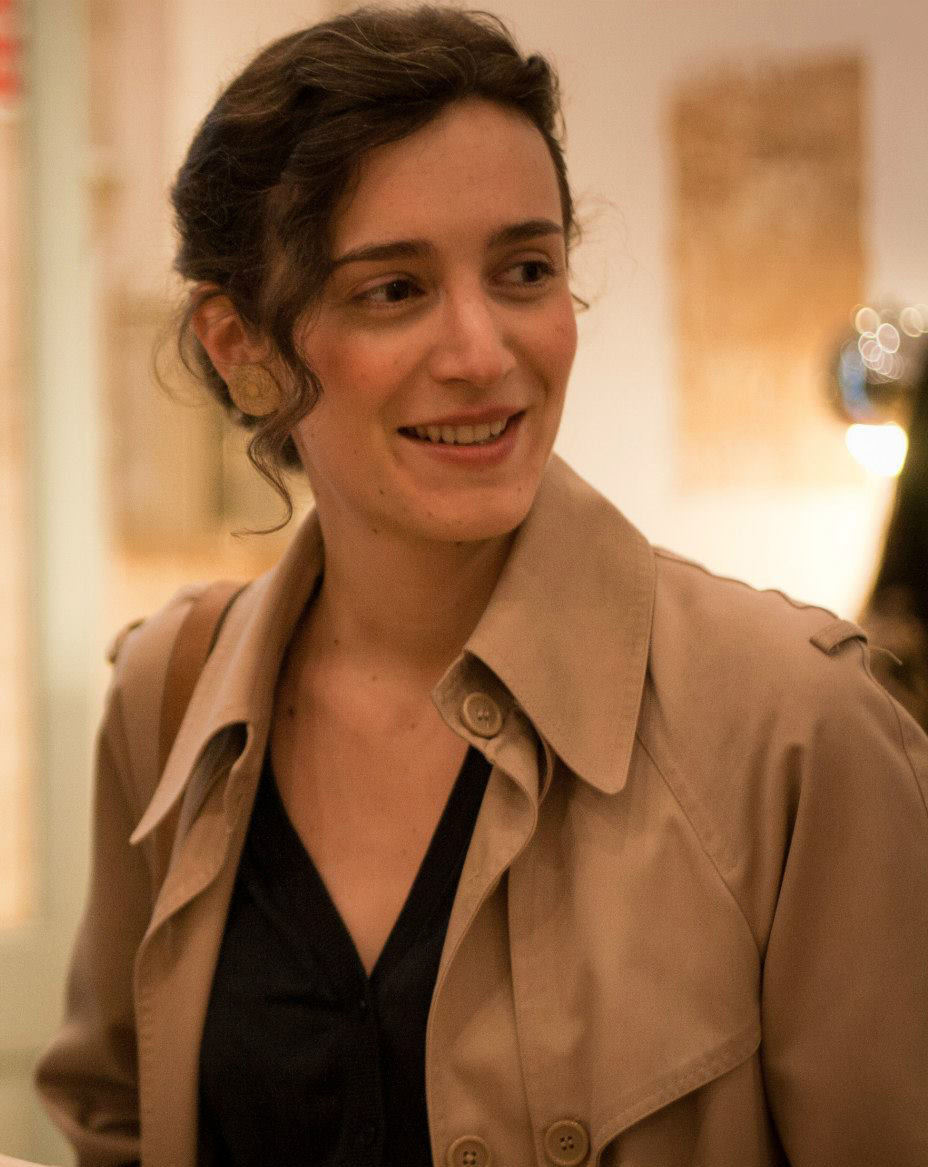Alice Waters, chef and co-founder of the famous Californian slow food restaurant Chez Panisse, summed up the close connection between art and cooking: “...they are both reactive and creative, imitating and adapting to each other.” So is there a connection between what happens in the studios of artists and what happens in their kitchens? Are there references to their work and personality? Are artists particularly creative when it comes to the everyday act of cooking? With the help of anecdotes and photos about their kitchens and eating habits, we provide insights into the culinary worlds of well-known artists.
This time we look at the word and food artist Daniel Spoerri and created (hopefully in his spirit) a little Spoerri ABC:
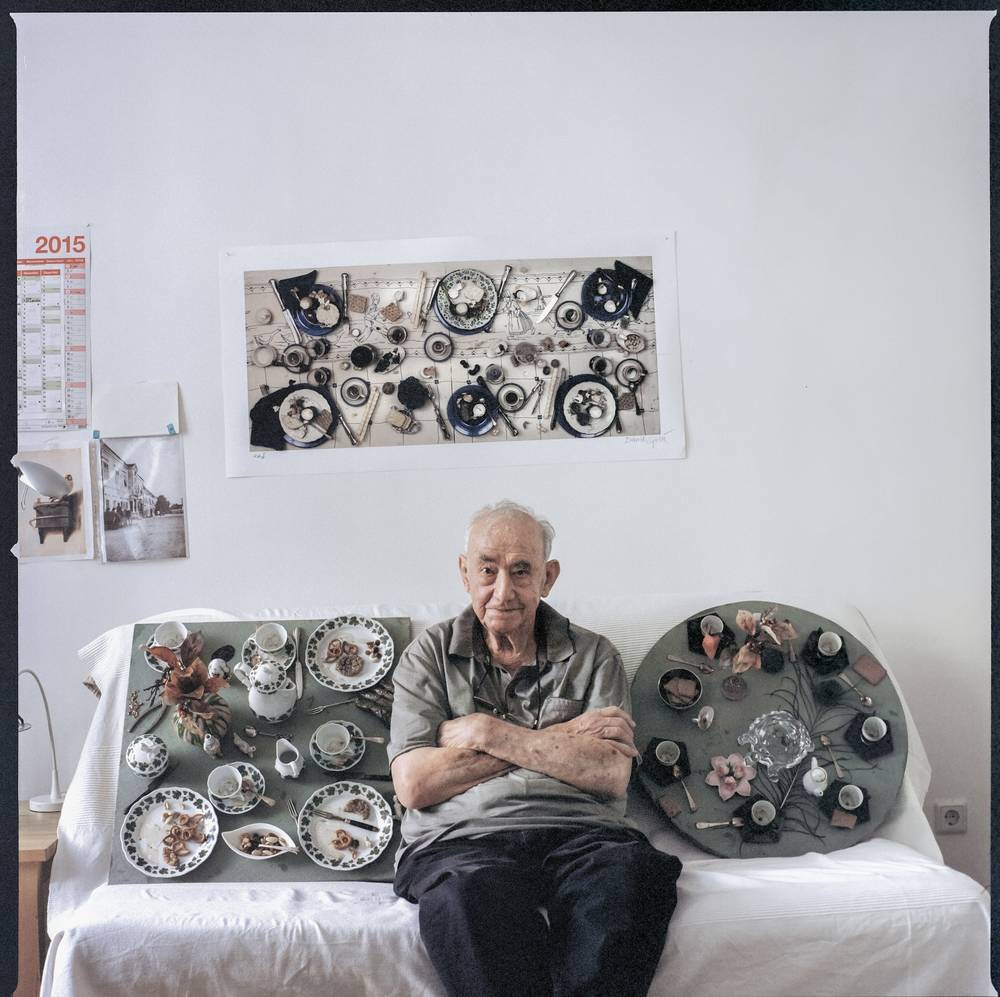
SPOERRI ABC
A is for Ab Ovo exhibition
It could really only be Daniel Spoeeri who could cook up the idea of organizing an exhibition that is only open for the time it takes to hard-boil an egg. The Swiss artist, who was born in Romania in 1930, systematically implemented this action at Cologne’s Galerie Zwirner in 1963, leaving his works hanging for a mere seven minutes. In doing so, Spoerri humorously upended the rules of the art market and, incidentally, also helped to fill his own stomach. The egg as a primeval form of food and symbol of life has fascinated Spoerri throughout his life: He has collected literary egg quotations along with all conceivable kitchen utensils for tackling eggs.
B is for Bread
There’s another basic building block of nutrition that plays an important role in Spoerri’s biography: bread. As a young, penniless student in Paris, he used to keep stale bread in a drawer and would subsequently simmer it in water with stock cubes at the end of the month to make bread soup. One day, he had the idea of buying a tin of cheap pepper, which drastically improved the taste of the soup. Spoerri dubbed this “wow” moment “the root of his cooking contagion”, the starting point of his lifelong passion for cooking.
C is for Catalogue Tabou
On the occasion of the “Grocery Store” exhibition in Copenhagen in 1961, Spoerri had eighty fresh rolls baked that were filled with garbage, nails and broken glass, and then proceeded to distribute them as a catalogue to visitors. This “Catalogue Tabou” was intended as a comment on food wastage, but the bakers’ guild nevertheless reacted indignantly and wrote letters of protest. The theme of bread popped up again in Spoerri’s work in 1970, this time in the form of everyday objects such as shoes or a typewriter, which the artist filled with dough and baked.
D is for Dinner
In addition to Object Art, in 1968 Spoerri discovered the staging of themed dinners as a means of self-expression. His spectacular banquets were intended to stimulate not just the stomach but also the mind: They called into question culinary and artistic conventions, highlighted socio-cultural aspects of food, and challenged the notions of taste among guests. Hence, he shocked participants at a goulash dinner in Heidelberg by announcing that they had just eaten horsemeat, only to revoke the claim shortly afterwards. Taking as his theme “The cuisine of the world’s poor”, Spoerri used just a few inexpensive ingredients to prepare extremely delicious and nutritious dishes for his guests, such as pea porridge with bacon or stockfish with potatoes.
E is for Eat Art
Spoerri invented the concept of “Eat Art” in the late 1960s as an overarching term for artistic exploration “of everything that is edible or seems edible”. The works created under this motto are testament to Spoerri’s interest in the cultural significance of eating and cooking, in the fundamental principles of nutrition, and in the act of eating as an existential process.
F is for “Fallenbilder”
When Spoerri came up with the idea in 1960 of sticking the remnants of a meal – dirty plates, emptied glasses, a crumpled cigarette packet – to the table precisely as he found them, then turning the base 90 degrees and hanging it on the wall, it was the birth of the first of his iconic “Fallenbilder”, or picture-traps. A year later, MoMA purchased one of these three-dimensional still lifes – with the remains of the breakfast consumed by his then girlfriend Kichka Baticheff – and he went on to produce countless variations over the course of his life. Letting “the trap snap shut” – i.e. capturing everyday objects in their spontaneous arrangement – at precisely the right moment in time is still a leitmotif of his work today.
G is for Gift Shop
Two years after his Düsseldorf restaurant was launched, Spoerri opened the matching Eat Art gallery on the next floor up with an exhibition of his bread dough objects. In the “souvenir shop”, as he jokingly dubbed the gallery, many of his artist friends and colleagues exhibited edible artworks, among them Joseph Beuys, Dieter Roth, André Thomkins, and Robert Filliou.
H is for Homonym Dinner
In 1978, Spoerri organized his “Hommage à Karl Marx”, a banquet to which he invited only guests who bore well-known names. Using the telephone book, he tracked down Johann Wolfgang Goethe, Richard Wagner, Friedrich Engels and many more “celebrities”, with a Herr Hinz and a Herr Kunz (the German equivalent of “Tom, Dick and Harry”) also represented. He also served suitably illustrious dishes: Schillerlocken, Mozartkugeln, Hitchcock orange juice and Bismarck herring.
I is for Island Life
In 1966, after almost ten years in Paris, where he had gained a foothold as an artist with Eat Art, Spoerri made a radical break: He moved with Kichka Baticheff to the remote Greek island of Symi to dedicate himself solely to cooking for an entire year. The limited range of foods available on the island, coupled with the absolute freshness of the ingredients – vegetables from the island gardens, fish caught just hours before, honey with the intense aroma of the herbs that grew in the stony ground – fueled Spoerri’s creativity. He made daily notes of what he cooked and ate and subsequently published a “Gastronomic Diary” of his trip in 1967.
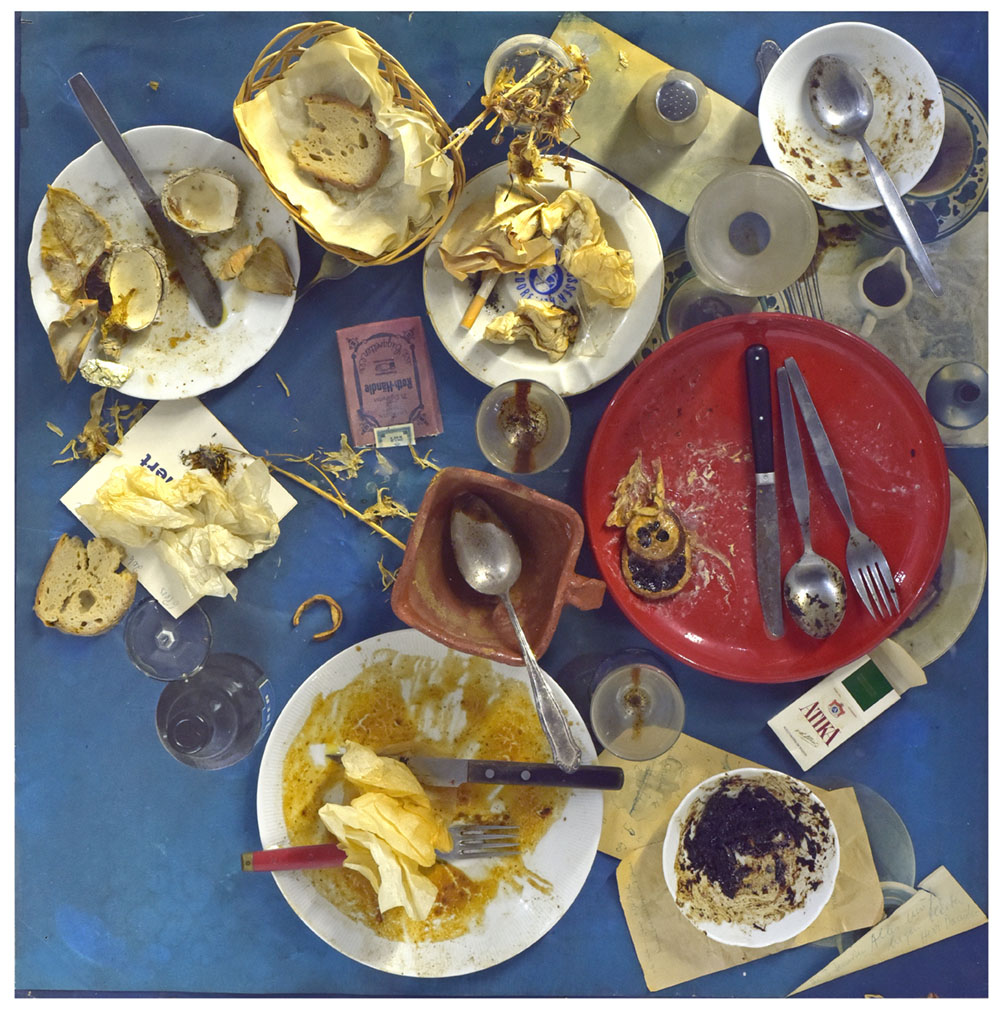
Daniel Spoerri, Aktion "Restaurant Spoerri" in Düsseldorf on 16 November 1972, ahlers collection, Image via kunstaspekte.art
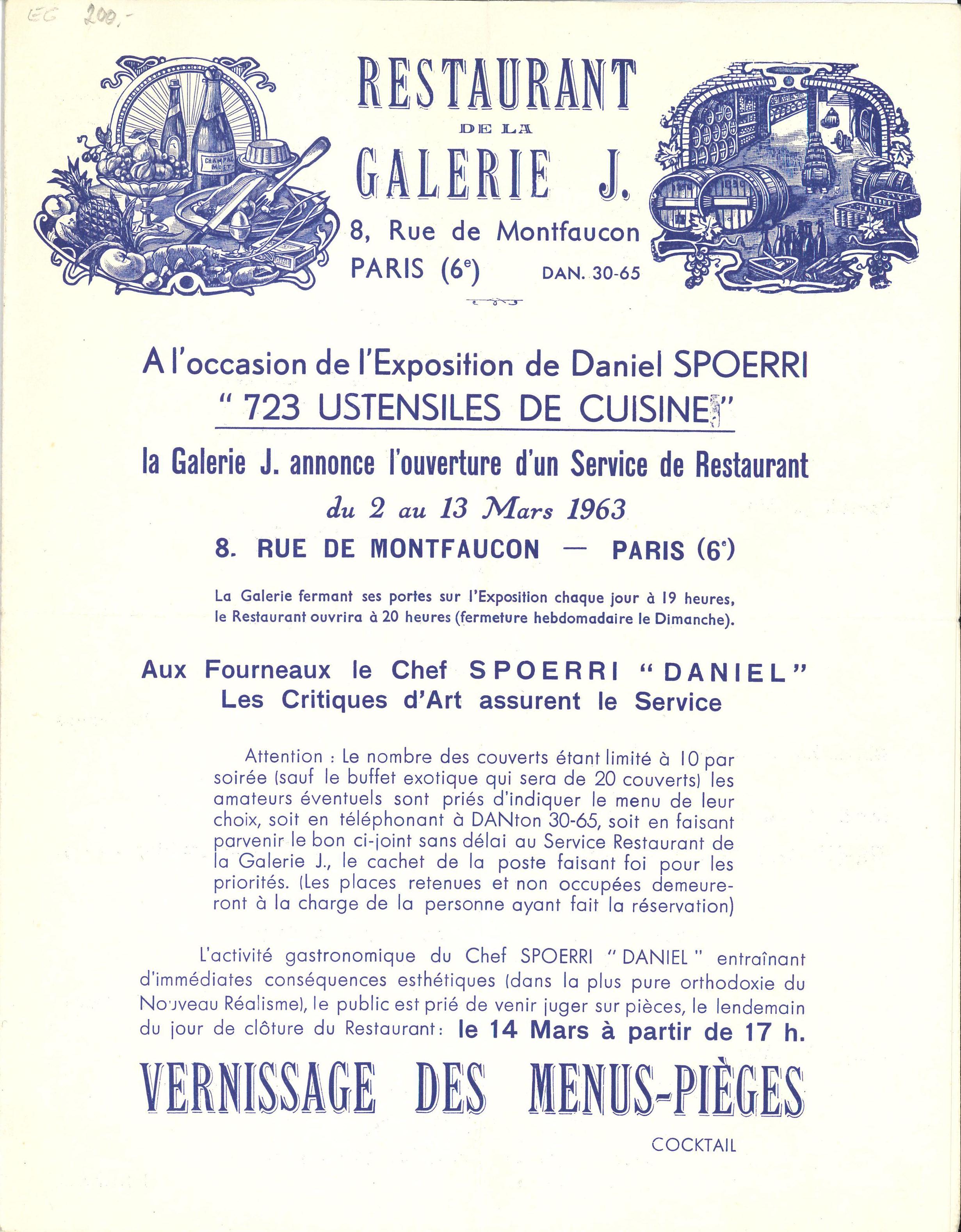
Daniel Spoerri, 723 USTENSILES DE CUISINE, Restaurant de la Galerie J., Paris, 1963, Image via ada-invitations.de
J wie Galerie J
In 1963, Spoerri achieved the ultimate fusion of art and gastronomy in an exhibition at the Galerie J in Paris: There, he opened a temporary restaurant and spent two weeks as “le Chef Daniel”, cooking a version of his conceptual banquet every evening for 30 guests. As waiters, he hired art critics, and at the end of every evening Spoerri selected a table that he fixed in its momentary state and then turned into one of his picture-traps.
K is for Kitchen Utensils
Fascinated by the diversity of everyday utility items, Spoerri collected kitchen utensils over many years. When he had amassed 723 kitchen items, he decided to reduce his collection and concentrate on potato peelers: “It seemed to me that the typically Swiss virtue of thrift was expressed most perfectly and ironically in this invention.” This became another collection that comprised 100 slightly varying potato peelers.
L is for LE PÂTISSIER PITTORESQUE
Spoerri lived out his passion for food not only practically, but also in theoretical terms: In the early 1970s he began collecting cookbooks and now owns more than 800 editions, including rarities such as the signed first edition of “Le pâtissier pittoresque” by Marie-Antoine Carême from the year 1815. Spoerri does not use recipes for cooking, however; at most, he takes the books as inspiration for new flavor combinations.
M is for menu
Shortly after his return from Symi, “le Chef Daniel” opened his “Restaurant Spoerri” in Düsseldorf in 1968. Alongside beef steaks, he also put python schnitzel, ant omelets and snake ragout on the menu with the aim of expanding his guests’ taste horizons; he created an ongoing series of picture-traps and decorated the walls with works by artist friends. More “multimedia super-happening artwork” than eatery, the place quickly became a central meeting point for the local art scene.
N is for Noveau Réalisme
“Art is life, life is art” was the motto of Noveau Réalisme, the artistic movement Spoerri co-founded in 1960 and which included his colleagues Yves Klein, Jean Tinguely, Niki de Saint Phalle and Raymond Hains, among others. Despite huge differences in their artistic practice, the members were united by a rejection of Abstract Expressionism and a determination to approach the reality of everyday life in their work.
O is for Ordinary and Wholesome
Spoerri prefers to eat simple, uncomplicated dishes. Michelin-starred cuisine with its strict set of rules is suspect to him, as are cookbooks with pages and pages of cooking instructions. You just need to know a few basic rules, then the cooking itself is actually pretty easy, he believes: “Without a lot of trallala – just add it, even burnt it sometimes tastes distinctive, but it just shouldn’t be soggy, and if it’s oversalted you can just add more water, milk, or something else.”
P is for Palindrome
Based on the principle of the palindrome, which reads the same backwards as it does forwards, Spoerri designed a series of Eat Art banquets: He served all courses in seemingly reverse order, starting with a cigar-shaped grissini, a coffee, which was actually a consommé served in coffee cups, and a dessert, which looked similar to an ice cream with chocolate pralines, but actually turned out to be mashed potatoes with meatballs.
Q is for Quality Space
A mere 12 square meters was the size of room number 13 at the Hotel Carcassonne in Paris, into which the artist moved shortly before his thirtieth birthday. He stayed for six years and despite the cramped quarters experienced great things there: production of the first picture-traps and the birth of his identity of an artist. As an homage to this formative place, in 1998 Spoerri had the room reconstructed true-to-life in bronze, for which he nevertheless had to rely entirely on his memory, since the owner barred him entry to the hotel, which still exists today, as he was annoyed by the Spoerri fans bombarding him with questions about the famous room.
R is for recipe (for spice balls)
In 1970, Spoerri published the following recipe in the magazine “Twen”, entitled “The love balls of Sheikh Muhammad Ibn-Muhammad an-Nafzawi”: “Crush in a mortar: 1 teaspoon each of black and white pepper, 1 teaspoon of coriander, 3 cloves, 2 whole nutmegs, 1 pinch of mace, 2 sticks of cinnamon. Finely chop: 250g each of dried figs, bananas, dates and apricots, 1-2 ginger roots in syrup. Finely chop: 250g total of hazelnuts, almonds, peanuts. Place in a large bowl: 250g raw cane sugar, 200g butter, 50g rosemary honey, 3 soup spoons of ginger syrup, 1 demitasse of Pernod. Add the other ingredients and knead well. Roll into nut-sized balls, coat in cane sugar and chill. The directions are for guidance only. More or lesser of one or the other ingredient may change the taste but perhaps only for the better.” A note on preparation time can be found under “T is for time”.
S is for Seasoning
Spoerri once compared the significance of art for society with the use of salt and pepper in preparing dishes. His own spice rack was appropriately well-stocked, and he exhibited it in its original form in 1963. In the enormous three by two-meter rack, the artist stored not only mustard and sambal pastes, but also ketchup and various Heinz sauces, angosturas, curry, lovage, dill and hyssop powder, as well as a pack of Maggi seasoning – an “aroma of home” that was irreplaceable for the Swiss artist.
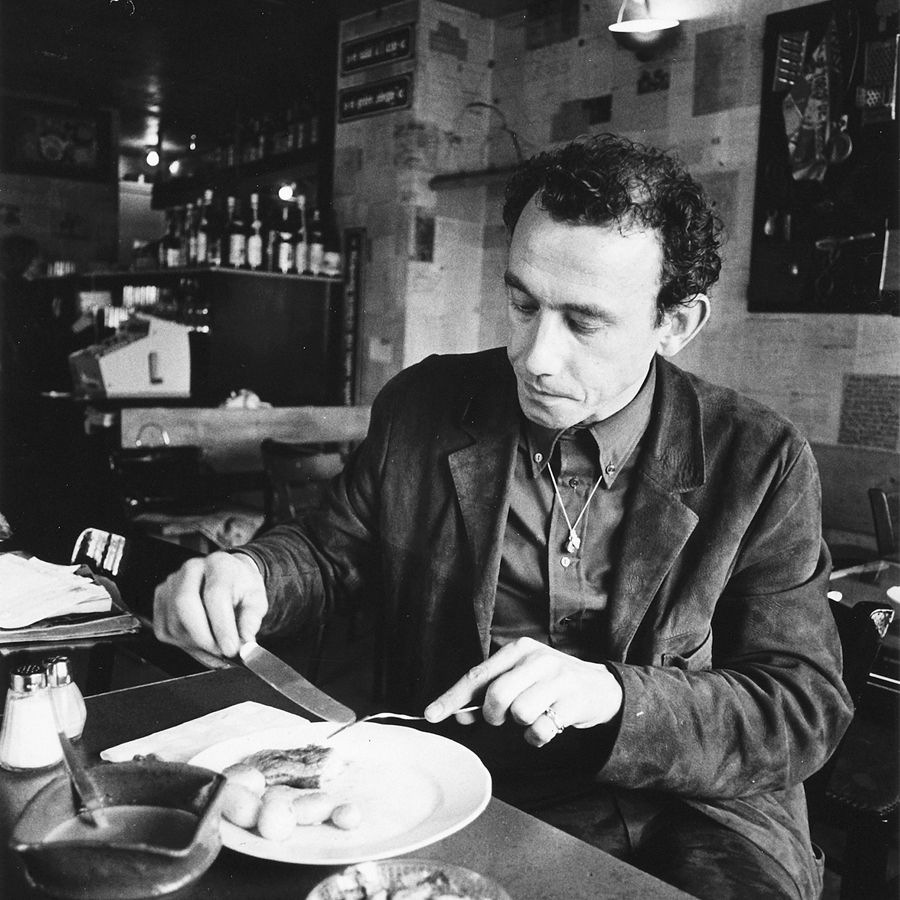
Daniel Spoerri, Image via www.spoerri.at
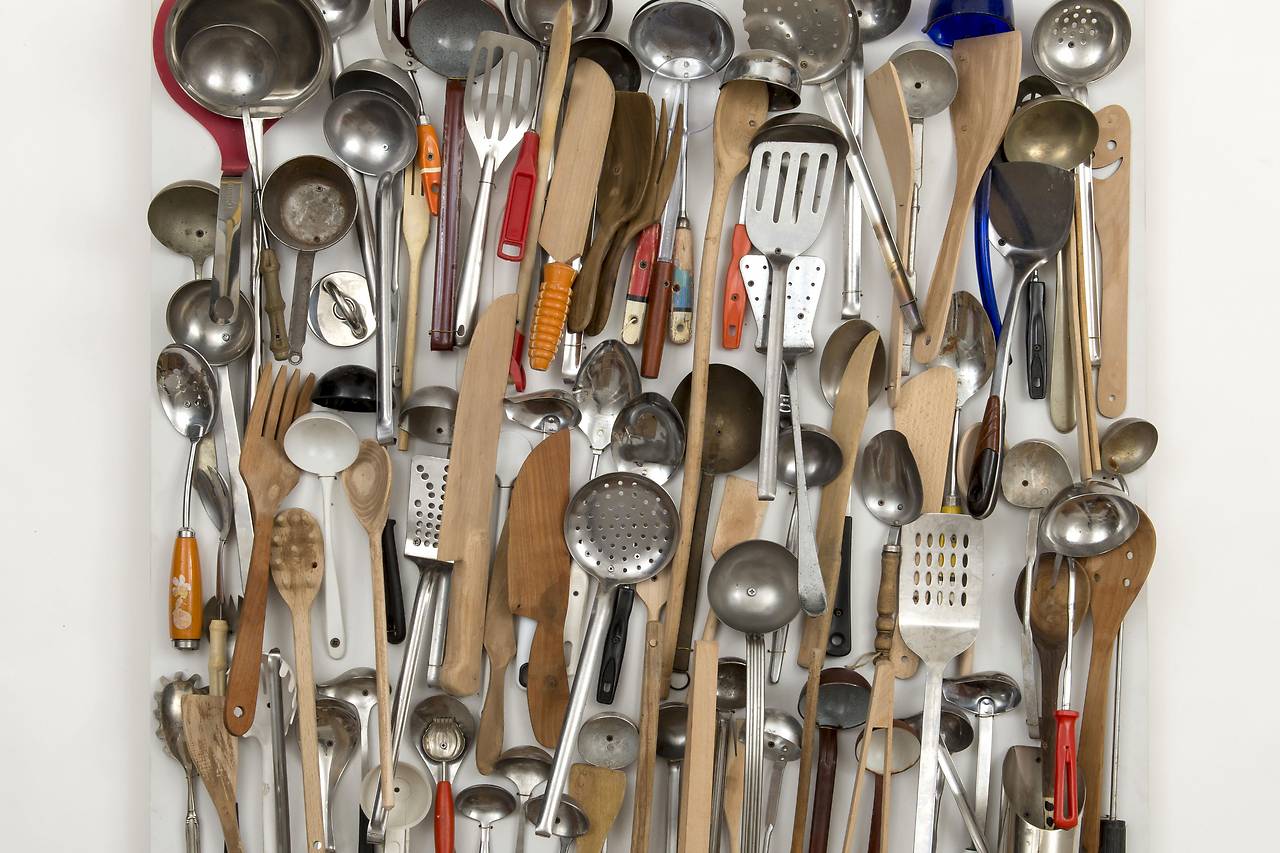
Exhibits from the exhibition „Daniel Spoerri & die Eat Art“, 2020, Ausstellungshaus Spoerri: Daniel Spoerri, Il Bistro di Santa Marta. Sammlung Küchenwerkzeuge, 2014, Image via noe.orf.at
T is for Time
While the time Spoerri spends fixing the objects of his picture-traps to their base makes him nervous, he actually finds cooking to be a form of meditation. He deliberately allows himself more time to cook than to eat and notes this accordingly as a comment on his spice ball recipe (see “R is for recipe”): “Of course these balls take time. After all, we’re not making them because we want to save time that we can use to go to the cinema, darn stockings or do whatever, but rather because we want to while away a couple of hours in the kitchen, mashing, kneading, stirring, and turning our kitchens into a laboratory of oriental scents, without forgetting to sip on a Pernod or two.”
U is for Ugo Dossi
His tireless drive to continually initiate new projects led Spoerri to southern Tuscany in the early 1990s, where he began laying out a sculpture park. “Il Giardino di Daniel Spoerri” has now been open for more than 20 years and covers a 16-hectare site that combines 113 installations by 55 artists, many of whom have been close friends and acquaintances of Spoerri for decades. One of them is Ugo Dossi, who presented edible chocolate embryos at the Eat Art gallery in 1971 and who is represented in the Giardino with the iron sculpture “The Kiss”.
V is for Vienna
After leading an almost nomadic life with countless different stages, including in Zurich, Paris, New York, Düsseldorf and Berlin, in 2008 Spoerri moved to Vienna, where he still lives today. Less than one hour’s drive away, in Hadersdorf am Kamp, he also put down roots, buying a former silent movie theater and a monastery building and transforming them into an exhibition venue, the “Kunst-Staulager AB ART”, and a slow-food restaurant that holds regular Eat Art banquets based on his ideas from the 1970s.
W is for Work Guides
“You are what you eat”, claimed the culinary philosopher Carl Friedrich von Rumohr back in 1822. His work “Geist der Kochkunst” (“Spirit of the Cooking Arts”), in which he called for a simple and seasonal diet and reflected on the interplay between cuisine and culture, had a lasting influence on Spoerri. He took it with him on his trip to Symi and peppered the “Gastronomic Diary” he compiled there with quotes from the book. Apparently, the two also shared a sense of humor: They both claimed to be “universal dilettantes”.
X is for “X pour Yves”
Ten years after the signing of the manifesto in Yves Klein’s studio in Paris, the Nouveaux Réalistes dissolved their movement. Spoerri organized a fitting farewell dinner in Milan: “L‘Ultima Cena”, the last supper. The menu, designed in the form of a black and silver sympathy card, was signed by all the members – only Yves Klein was missing as he had died some years earlier. In his place, his former wife Rotraud Uecker signed “X pour Yves”.
Y is for Yves Klein
Das Beerdigungsbankett des Nouveau Réalisme am 19. November 1970 wurde eine der aufwendigsten Dinner, die Spoerri bis dato umgesetzt hatte. Jeder Künstler*innen der Gruppierung bekam seinen eigenen Tisch, auf dem eine essbare Interpretation seiner Werke serviert wurde. Für Yves Klein gab Spoerri eine Reproduktion seines Bildes „Ci-gît l’espace“ in Form einer riesigen, mit Blattgold überzogenen Cremetorte in Auftrag, die mit Schaumzuckerschwämmen und rosa Marzipanrosen dekoriert war.
Z is for Zest
Spoerri’s work as an object artist and organizer of culinary happenings was what brought him the greatest recognition, but a look at his curriculum vitae reveals him to be a talented jack-of-all-trades. After trying his hand in his youth as a shoeshine boy, vegetable seller, trader, photographer and tour guide, he had a lightning career in the ballet – even making it to the Stadttheater Bern as a solo dancer. He also worked as a director and poet, and only afterwards devoted himself to the visual arts. Yet he remained true to his versatility and acted, often simultaneously, as a bookseller, restaurant owner, exhibition organizer, writer, and professor.
